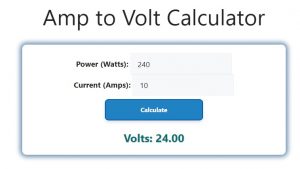About Amp to Volt Calculator (Formula)
In the field of electrical engineering, understanding the relationship between power, current, and voltage is fundamental. The Amp to Volt Calculator is a useful tool designed to help users convert power measured in watts and current measured in amperes into voltage measured in volts. This calculator can be particularly helpful for engineers, electricians, and DIY enthusiasts who need to quickly assess voltage in their electrical circuits. In this article, we will explain the formula used in the calculator, how to use it effectively, provide a practical example, and answer some frequently asked questions.
Formula
The formula for calculating voltage based on power and current is:
Voltage (V) = Power (P) / Current (I)
Where:
- Voltage (V) is measured in volts.
- Power (P) is measured in watts.
- Current (I) is measured in amperes.
How to Use
- Determine Power: Identify the power consumption in watts (P) of the device or circuit you are analyzing.
- Measure Current: Measure or obtain the current (I) in amperes flowing through the circuit.
- Input Values: Enter the values for power and current into the Amp to Volt Calculator.
- Calculate Voltage: Click the calculate button to find the voltage (V) in volts.
Example
Let’s consider a scenario where you have an electrical device that consumes 240 watts of power and operates with a current of 10 amperes.
- Power (P) = 240 W
- Current (I) = 10 A
Using the formula:
Voltage (V) = Power (P) / Current (I)
Substituting the values:
Voltage (V) = 240 W / 10 A
Voltage (V) = 24 V
Therefore, the voltage across the device is 24 volts.

FAQs
- What is an ampere?
An ampere (A) is the unit of measurement for electric current, indicating how much electricity flows in a circuit. - What is a volt?
A volt (V) measures the electric potential difference, representing the force that drives electric current through a circuit. - What does the formula represent?
The formula shows the relationship between power, current, and voltage, allowing users to calculate one if the other two are known. - Can this calculator be used for both AC and DC circuits?
Yes, the Amp to Volt Calculator can be applied to both AC (Alternating Current) and DC (Direct Current) circuits. - What happens if I enter a zero current value?
Entering a zero current value will result in an undefined voltage calculation, as it leads to division by zero. - How do I measure the current in a circuit?
Use a multimeter set to measure current in series with the circuit to obtain accurate readings. - What is the significance of the power factor in AC circuits?
The power factor indicates how efficiently electrical power is being converted into useful work output and affects the actual voltage and current. - How can I convert volts back to amps?
You can convert volts back to amps using the formula: Current (I) = Power (P) / Voltage (V). - Is this calculator useful for calculating battery power?
Yes, it can be used to determine voltage for battery-powered devices by inputting the power and current values. - How accurate is the calculation from this calculator?
The accuracy depends on the precision of the input values for power and current. - What safety precautions should I take when measuring current?
Always ensure the multimeter is set to the correct mode and range to avoid damage or injury. - How do I calculate total power consumption for multiple devices?
Add the power ratings of all devices together to determine the total power consumption. - Can I use this calculator for high-power systems?
Yes, but be sure to handle high-power systems safely and understand the specifications of the components involved. - What is the impact of resistance on the circuit?
Resistance affects current flow; according to Ohm’s law, Voltage = Current × Resistance. - What are common units for measuring power?
Power is commonly measured in watts (W), but can also be expressed in kilowatts (kW) for larger systems. - Where can I find more resources on electrical calculations?
Numerous engineering websites, textbooks, and online forums provide valuable information on electrical calculations. - How does temperature affect electrical measurements?
Temperature can influence resistance and current flow, affecting overall circuit performance. - What type of devices can I use this calculator for?
The calculator is suitable for various devices, including motors, appliances, and lighting systems. - What if I don’t know the power consumed?
If the power is unknown, it can be calculated using the formula Power = Voltage × Current. - Is it important to understand these calculations?
Yes, understanding these calculations is vital for designing safe and efficient electrical systems.
Conclusion
The Amp to Volt Calculator is an essential tool for anyone involved in electrical work, providing a quick and efficient means to convert power and current into voltage. By understanding the formula and its applications, you can make informed decisions in your electrical projects. The FAQs included offer additional insights and clarify common uncertainties, empowering you with the knowledge necessary for effective electrical management.